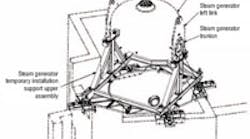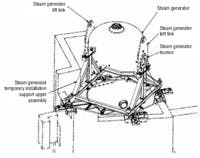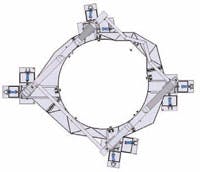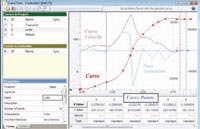Hydraulic Robot Provides Precise Positioning
There’s no power source that can compete with hydraulics in terms of cost and reliability when heavy loads must be moved. And with the proper controls, heavy loads can be positioned very precisely by hydraulic robots. For example, a new hydraulic robot has been constructed by Premier Technology Inc., Blackfoot, Idaho, under contract to Westinghouse Electric Co. The robot is being used to precisely position 800-ton steam generator units during the construction of two new AP1000 nuclear reactors in China.
The robot frame, Figure 1, is set in place and the steam generator is lowered into the center of it by a heavy-duty crane. Sixteen hydraulic rams on the robot frame are needed to position the steam generator for precise connection to the reactor plumbing: Four axes lift it, four more axes tilt it, and eight axes move the steam generator horizontally and rotate it as necessary.
The vertical motion is relatively simple to calculate and control, so the eight lifting and tilting rams are controlled directly by an Allen-Bradley ControlLogix PLC. The most complex motion happens in the horizontal plane, and Premier Technology specified the use of precision electrohydraulic motion controllers to control the eight horizontal positioning cylinders.
Figure 2 shows a vertical view down on the top of the robot structure. The cylindrical steam generator fits in the circular opening at the center of the structure. Each of the eight horizontal axes must move independently according to the results of a set of complex mathematical functions. The horizontal hydraulic cylinders (closeup in Figure 3) can achieve a maximum travel of 8 in., which enables a steam generator to be moved as much as 4 in. in each direction. The specification required being able to move the generator up to 2 in. in any direction to within a tolerance of 132 in., so the robot was designed with added flexibility.
To control the motion of the eight horizontal axes, Premier selected the RMC 75 two-axis motion controller, manufactured by Delta Computer Systems Inc. “We could have gone with Delta’s eight-axis RMC150 controller,” said Robert Cockrell, engineer with Premier Technology, “but we saved wiring by mounting a two-axis controller at each corner of the frame.” The RMC motion controllers connect to the master PLC via EtherNet IP.
Programming the motion
Premier teamed with Integrated Solutions & Designs Inc., Nampa, Idaho, to assist in programing the motion controllers. “I had never used a Delta RMC controller before,” said Kevin Skinner, engineer with Integrated Solutions & Designs. “I took Delta’s online training course and quickly realized how easy the controllers are to use. Other controllers that I’ve used required complex syntax and reams of instructions to accomplish a task. With the RMC, the code is simple and intuitive, resulting in reduced development time.
“It took us a couple program iterations in order to get the system to work properly,” continued Skinner. “At first, the system wouldn’t extend and retract the adjacent cylinders correctly in order to twist the robot frame, but Delta offers a curve tool, which fixed the problem.”
The Delta Curve Tool, which is part of the RMCTools software package, enables motion axes to achieve smooth curving motion by fitting a curve to a set of target points. In this robotic application, the control pro gram for each axis builds a motion curve based on the set of target points given to it by the PLC.
“We converted from using simple move instructions to using the Curve Tool while still working with the motion simulator that is built into Delta’s RMC,” said Skinner. “Using the simulator, I was able to write the entire program and test it out at my desk before the hardware was connected. This saved time and hassle in proving out our design.”
Now, the PLC sends the correct curve points to each of the RMC75s over Ethernet and synchronizes the motion initialization. Using the data from the PLC, the RMC’s curve tool allows for smooth motion regardless of the length of the move.
Selecting system components
Each hydraulic cylinder (axis) was fitted with an analog position indicator to provide position feedback to the motion controller, and servo quality proportional valves to precisely control the hydraulics.
The position indicators were selected to provide a more cost effective solution, but they introduced noise into the system that required the installation of signal filters, generally negating the cost advantages. “We found the problems by using Delta Computer Systems’ Plot Manager and Tuning Wizard tools,” said Skinner. “Delta’s software identified the noise problem on the analog lines—the actual motion profiles weren’t matching the targets.”
In addition, the selected analog position sensors proved to be prone to breakage.
“We ended up breaking five of them during the design checkout process,” Cockrell said. “Ultimately they worked, but it would have been better had we provided some type of protective covering for the sensors.”
“A better solution would have been to use a sensor integrated directly into the cylinder,” continued Cockrell. “Because they would be built into the cylinders they would provide a more rugged solution. Plus, because they’re digital, they’re not prone to the noise problems of the analog solution.”
Two hydraulic systems were built and tested simultaneously over several days without being connected to the frame. Then additional testing was done once the robot structure was completed and the frames assembled. Both systems performed to specifications after multiple test moves while under load. This application proves that even systems that are not motion intensive can benefit from precise hydraulic controls.
Why is this robotic apparatus necessary? Wouldn’t it be possible to use a crane to move the steam generator precisely into position? The answer is “not reliably.” It is critical that the plumbing be connected only very slowly and deliberately in order to avoid putting strain on the connections. This application proves that the easiest solution to complex motion problems may be to use an electrohydraulic motion controller, even when you just need to move a heavy load a few inches.
For more information, visit www.deltamotion.com or contact the author at [email protected].





